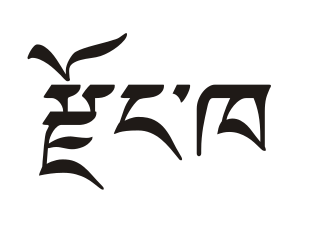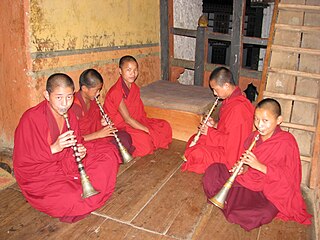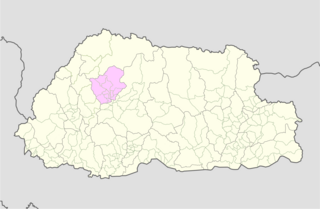| Laya Gewog | |
|---|---|
| Gewog | |
| Coordinates: 28°00′00″N89°40′00″E / 28.00000°N 89.66667°E | |
| Country | |
| District | Gasa District |
| Time zone | BTT (UTC+6) |
Laya Gewog is a gewog (village block) of Gasa District, Bhutan. [1] The capital of gewog is the town Laya.

Gasa District or Gasa Dzongkhag is one of the 20 dzongkhags (districts) comprising Bhutan. The northern part of Gasa District is a disputed zone under the control of the People's Republic of China. The capital of Gasa District is Gasa Dzong near Gasa. It is located in the far north of the county and spans the Middle and High regions of the Tibetan Himalayas. The dominant language of the district is Dzongkha, which is the national language. Related languages, Layakha and Lunanakha, are spoken by semi-nomadic communities in the north of the district.

Bhutan, officially the Kingdom of Bhutan, is a landlocked country in South Asia. Located in the Eastern Himalayas, it is bordered by Tibet Autonomous Region of China in the north, the Sikkim state of India and the Chumbi Valley of Tibet in the west, the Arunachal Pradesh state of India in the east, and the states of Assam and West Bengal in the south. Bhutan is geopolitically in East Asia and is the region's second least populous nation after the Maldives. Thimphu is its capital and largest city, while Phuntsholing is its financial center.

Laya, Bhutan is a town in Laya Gewog in Gasa District in northwestern Bhutan. It is inhabited by the indigenous Layap people, and is the highest settlement in the country.
The gewog lies entirely within Jigme Dorji National Park and contains several of Bhutan's glaciers.

The Jigme Dorji National Park (JDNP), named after the late Jigme Dorji Wangchuck, is the second-largest National Park of Bhutan. It occupies almost the entire Gasa District, as well as the northern areas of Thimphu District, Paro District, Punakha, and Wangdue Phodrang Districts. It was established in 1974 and stretches over an area of 4316 km², thereby spanning all three climate zones of Bhutan, ranging in elevation from 1400 to over 7000 meters. About 6,500 people in 1,000 households live within the park, from subsistence agriculture and animal husbandry. It is listed as a tentative site in Bhutan's Tentative List for UNESCO inclusion.
The glaciers of Bhutan, which covered about 10 percent of the total surface area in the 1980s, are an important renewable source of water for Bhutan's rivers. Fed by fresh snow each winter and slow melting in the summer, the glaciers bring millions of litres of fresh water to Bhutan and downriver areas each year. Glacial melt also adds to monsoon-swollen rivers which may be a contributing factor to flooding. Where glacial movement temporary blocks riverflows, downstream areas may be threatened by glacial lake outburst flood ("GLOFs"). Although GLOFs are not a new phenomenon in Bhutan, their frequency has risen in the past three decades. Significant GLOFs occurred in 1957, 1960, 1968 and 1994, devastating lives and property downstream. According to the Bhutan Department of Energy however, the majority of rivers in Bhutan are more susceptible to fluctuation with changing rainfall patterns than to flooding directly attributable to glacier or snow melt.
As well as the national language, Dzongkha, many locals speak Layakha.

Dzongkha, or Bhutanese, is a Sino-Tibetan language spoken by over half a million people in Bhutan; it is the sole official and national language of the Kingdom of Bhutan. The Tibetan alphabet is used to write Dzongkha.
The closure of the Tibetan border following the Chinese invasion of Tibet brought several changes to the area. Local people were no longer compelled to work as porters for Tibetan and Bhutanese officials, nobles, or religious figures from Gasa Dzong. Refugees from Tibet arrived with their yaks, which they sold off at low prices. Taxes on horses and yaks, which had been a disincentive to livestock production were reduced, and yak production increased. [2]

The Battle of Chamdo occurred from 6 through 19 October 1950. It was a military campaign by the People's Republic of China (PRC) to retake the Chamdo Region from a de facto independent Tibetan government after months of failed negotiations on the status of Tibet. At the time, most countries of the world, as well as the United Nations, recognized Tibet as a part of the preceding Republic of China (ROC). The campaign aimed not to invade Tibet per se but to capture the Lhasa army occupying Chamdo, demoralize the Lhasa government, and to exert pressure to get Tibetan representatives to agree to negotiations in Beijing and sign terms recognizing China's sovereignty over Tibet. The campaign resulted in the capture of Chamdo and further negotiations between the PRC and Tibetan representatives that eventually resulted in the incorporation of Tibet into the People's Republic of China.

Not to be confused with: Gasa, Bhutan or Gasa District

The domestic yak is a long-haired domesticated bovid found throughout the Himalayan region of the Indian subcontinent, the Tibetan Plateau and as far north as Mongolia and Russia. It is descended from the wild yak.








